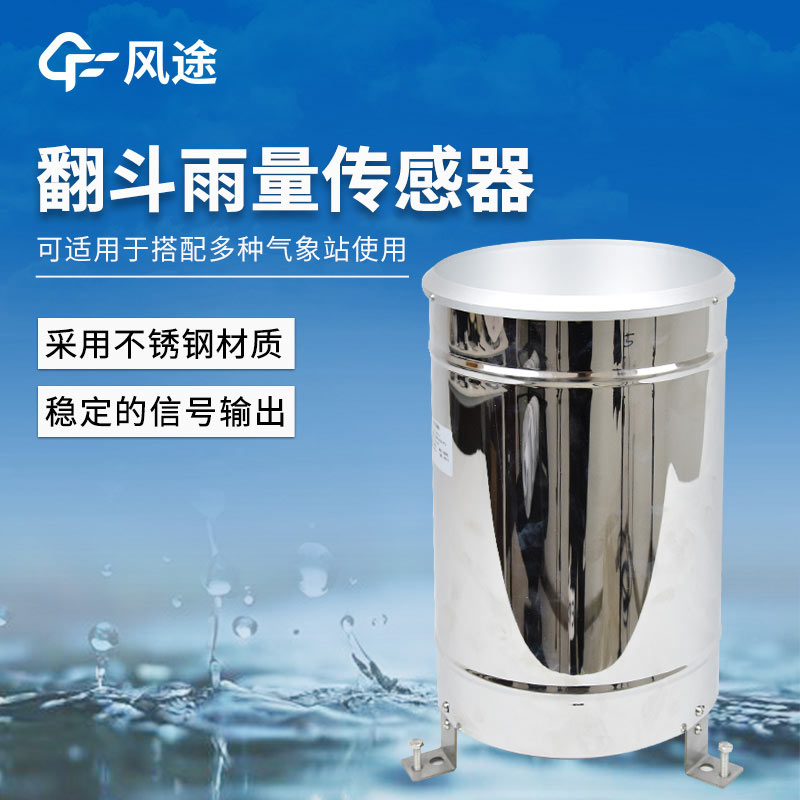Shandong Fengtu IOT Technology Co., Ltd
Sales Manager:Ms. Emily Wang
Cel,Whatsapp,Wechat:+86 15898932201
Email:info@fengtutec.com
Add:No. 155 Optoelectronic Industry Accelerator, Gaoxin District, Weifang, Shandong, China

Sales Manager:Ms. Emily Wang
Cel,Whatsapp,Wechat:+86 15898932201
Email:info@fengtutec.com
Add:No. 155 Optoelectronic Industry Accelerator, Gaoxin District, Weifang, Shandong, China
time:2025-07-10 09:34:16 source:Weather Station viewed:217 time
The Stainless Steel Tipping Bucket Rain Gauge is the most classic rain gauge. It collects rainwater through an inclined funnel. When the rainwater reaches a certain amount, the tipping bucket below tilts and dumps the water. After the sensor detects this action, the rainfall can be determined.
It can record precipitation in real time and accurately, unaffected by dust or shadows, and can maintain high measurement accuracy even under severe weather conditions. Moreover, the national standard GB/T 21978.2-2014 provides unified technical specifications and quality standards for the production, testing, and use of tipping bucket rain gauges.
The editor reminds that when choosing a tipping bucket rain gauge, the following key points that comply with national standards should be focused on:
Structure and composition: It can be divided into single-layer, double-layer, and three-layer forms according to the number of tipping bucket layers. For example, the upper layer of the double-layer Stainless Steel Tipping Bucket Rain Gauge is a transition bucket, and the lower layer is a measuring bucket, which can evenly inject precipitation of different intensities into the measuring bucket, improving detection accuracy.
Measurement accuracy: Within the rainfall intensity range of 0.01mm/min to 4.0mm/min, the accuracy is divided into three grades. High-quality products can achieve an error of ≤±2%, reaching Class I accuracy, and have passed professional institution testing.
Rain collection mouth: The inner diameter needs to be φ200mm, the edge is blade-shaped, the angle is between 40° and 45°, the inner wall is smooth, and the depth is at least 100mm. The material is mostly 304 stainless steel to prevent rainwater splashing and corrosion.
Resolution: There are various specifications such as 0.1mm, 0.2mm, and 0.5mm available, which should be selected according to actual needs.
Rainfall measurement intensity range: The conventional measurable range is 0mm/min to 4mm/min, the maximum allowable rain intensity is 8mm/min, and some products support customization for greater rain intensity.
Output: The signaling element is recommended to use a reed switch, which meets national standard requirements and can ensure the stability of signal output.

As an important part of the power system, the safe operation of the transmission line directly affects the social and economic development. Therefore, in the actual production, it is necessary to do a good job in the maintenance of the transmission line to ensure that the transmission line has good...
The 50KM Visibility sensor is a measuring instrument in industries such as road traffic and meteorology. It uses the forward scattering method to measure the total extinction coefficient of the air and thus obtain accurate visibility data.This sensor uses an aluminum shell, which is anodized and pai...
In agricultural production, pest infestations restrict crop yield and quality. Traditional manual inspection-based monitoring is labor-intensive and time-consuming, with limitations such as a narrow coverage range and delayed data, making it difficult to provide accurate support for pest prevention...
scenic weather station is a monitoring facility integrating data acquisition, storage, transmission, and management,It continuously monitors air quality and temperature/humidity to ensure the environmental quality of the scenic area....